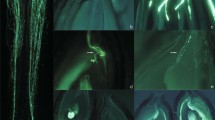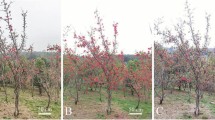Summary
Differences in pollen performance in higher plants can result in significant selective advantages for some particular genotypes leading to both gametophytic and sexual selection. However, the possibility of selection among male gametophytes has been questioned since natural selection could lead to the fixation of alleles for the best competing male genotypes. These two apparently conflicting hypotheses could be reconciled if pollen performance, rather than operating in absolute terms, could be modulated by the pistilar genotype. Thus, pollen performance in vivo and in vitro has been compared in four sweet cherry (Primus avium L.) cultivars. Differences among the cultivars studied have been recorded in the speed and final pollen germination percentages both in vivo and in vitro. The results obtained show that the female genotype also modulates the final result of pollen performance. These two factors are not merely additive but, on the contrary, the interaction between them affects pollen behavior in vivo. This fact has clear implications for gametophytic and sexual selection since the best male-female combinations can be favored and this could explain the variability observed for pollen performance in nature.
Similar content being viewed by others
References
Barnes DK, Cleveland RW (1963a) Pollen tube growth of diploid alfalfa in vitro. Crop Sci 3: 291–295
— — (1963b) Genetic evidence for non-random fertilization in alfalfa as influenced by differential pollen tube growth. Crop Sci 3: 295–297
Bookman SS (1984) Evidence for selective fruit production inAsclepias. Evolution 38: 72–86
Cerovic R, Ruzic D (1992) Pollen tube growth in sour cherry (Prunus cerasus L.) at different temperatures. J Hortic Sci 67: 333–340
Cheung AY (1995) Pollen-pistil interactions in compatible pollination. Proc Natl Acad Sci USA 92: 3077–3080
Crane MB, Brown AG (1937) Incompatibility and sterility in the sweet cherry,Prunus avium L. J Pomol 15: 86–116
Cruzan MB (1993) Analysis of pollen-style interactions inPetunia hybrida: the determination of variance in male reproductive success. Sex Plant Reprod 6: 275–281
Dane F, Melton B (1973) Effect of temperature on self- and crosscompatibility and in vitro pollen growth characteristics in alfalfa. Crop Sci 13: 587–591
Derksen J, Rutten T, van Amstel T, de Win A, Doris F, Steer M (1995) Regulation of pollen tube growth. Acta Bot Neerl 44: 93–119
Ganeshaiah KN, Uma Shaanker R (1988) Regulation of seed number and female incitation of mate competition by a pH-dependent proteinaceous inhibitor of pollen grain germination inLeucaena leucocephala. Oecologia 75: 110–113
— —, Shivashanker G (1986) Stigmatic inhibition of pollen grain germination: its implication for frequency distribution of seed number in pods ofLeucaena leucocephala. Theor Appl Genet 72: 84–87
Gawel NJ, Robacker CD (1986) Effect of pollen-style interaction on the pollen tube growth ofGossypium hirsutum. Theot Appl Genet 72: 84–87
Herrero M (1992) From pollination to fertilization in fruit trees. Plant Growth Regul 11: 27–32
—, Dickinson HG (1981) Pollen tube development inPetunia hybrida following compatible and incompatible intraspecific matings. J Cell Sci 47: 365–383
—, Hormaza JI (1996) Pistil strategies controlling pollen tube growth. Sex Plant Reprod 9: 343–347
Hormaza JI, Herrero M (1996) Dynamics of pollen tube growth under different competition regimes. Sex Plant Reprod 9: 153–160
Jefferies CJ, Belcher AR (1974) A fluorescent brightener used for pollen tube identification in vivo. Stain Technol 49: 199–202
Kandasamy MK, Nasrallah JB, Nasrallah ME (1994) Pollen-pistil interactions and developmental regulation of pollen tube growth in Arabidopsis. Development 120: 3405–3418
Knox RB (1984) Pollen-pistil interactions. In: Linskens HF, Heslop-Harrison J (eds) Cellular interactions. Springer, Berlin Heidelberg New York Tokyo, pp 508–608 (Pirson A, Zimmermann MH [eds] Encyclopedia of plant physiology, new series, vol 17)
Lewis D (1944) Incompatibility in plants: its genetical and physiological synthesis. Nature 153: 578
— (1994) Gametophytic-sporophytic incompatibility. In: Williams EG, Clarke AE, Knox RB (eds) Genetic control of self-incompatibility and reproductive development in flowering plants. Kluwer, Dordrecht, pp 88–101
Linskens HF, Esser K (1957) Über eine spezifische Anfärbung der Pollenschläuche und die Zahl der Kallosapropfen nach Selbstung und Fremdung. Naturwissenschaften 44: 16
—, Pfahler PL (1977) Genotypic effects on the amino acid relationships in maize (Zea mays L.). Theor Appl Genet 50: 173–177
Malti, Shivanna KR (1985) The role of the pistil in screening compatible pollen. Theor Appl Genet 70: 684–686
Mazer SJ (1987) Parental effects on seed development and seed yield inRaphanus raphanistrum: implications for natural and sexual selection. Evolution 41: 355–371
Mulcahy DL (1979) The rise of angiosperms: a genecological factor. Sci 206: 20–23
—, Sari-Gorla M, Mulcahy GB (1996) Pollen selection: past, present and future. Sex Plant Reprod 9: 353–356
Mulcahy GB, Mulcahy DL (1983) A comparison of pollen tube growth in bi and trinucleate pollen. In: Mulcahy DL, Ottaviano E (eds) Pollen: biology and implications for plant breeding. Elsevier, New York, pp 29–33
Murdy WH, Carter MEB (1987) Regulation of the timing of pollen germination by the pistil inTalinum mengesii (Portulacaceae). Am J Bot 74: 1888–1892
Nettancourt D de (1977) Incompatibility in angiosperms. Springer, Berlin Heidelberg New York
Pfahler PL (1967) In vitro germination and pollen tube growth of maize (Zea mays L.) pollen I: calcium and boron effects. Can J Bot 45: 839–845
Pfahler PL, Linskens HF (1972) In vitro germination and pollen tube growth of maize (Zea mays L.) pollen VI: combined effects of storage and the alleles at the waxy (wx), sugary (su 1) and shrunken (sh 2) loci. Theor Appl Genet 42: 136–140
—, Pereira MJ, Barnett RD (1997) Genetic variation for in vitro sesame pollen germination and tube growth. Theor Appl Genet 95: 1218–1222
Sari-Gorla M, Ottaviano E, Faini D (1975) Genetic variability of gametophytic growth rate in maize. Theor Appl Genet 46: 289–294
— —, Bellintani R (1976) Competitive ability of maize pollen: interaction between genotypes of pollen and stylar tissues. Maydica 21: 77–80
Schemske DW, Fenster C (1983) Pollen grain interactions in a neotropicalCostus: effects of clump size and competitors. In: Mulcahy DL, Ottaviano E (eds) Pollen: biology and implications for plant breeding. Elsevier, New York, pp 405–417
Shivanna KR, Linskens HF, Cresti M (1991) Pollen viability and pollen vigor. Theor Appl Genet 81: 38–42
Snow AA, Spira T (1991) Pollen vigor and the potential for sexual selection in plants. Nature 352: 796–797
Spira, TP, Snow AA, Puterbaugh MN (1996) The timing and effectiveness of sequential pollinations inHibiscus moscheutos. Oecologia 105: 230–235
Stephenson RB, Bertin RI (1983) Male competition, female choice and sexual selection in plants. In: Real L (ed) Pollination biology. Academic Press, New York, pp 110–149
Taylor LP, Hepler PK (1997) Pollen germination and tube growth. Annu Rev Plant Physiol Plant Mol Biol 48: 461–491
Tehrani G, Lay W (1991) Verification through pollen incompatibility studies of pedigrees of sweet cherry cultivars from Vineland. HortScience 26: 190–191
Thomson JD (1989) Germination schedules of pollen grains: implications for pollen selection. Evolution 43: 220–223
—, Rigney LP, Karoly KM, Thomson BA (1994) Pollen viability, vigor and competitive ability inErythronium grandiflorum (Liliaceae). Am J Bot 81: 1257–1266
Walsh NE, Charlesworth D (1992) Evolutionary interpretations of differences in pollen tube growth rates. Q Rev Biol 67: 19–37
Wolters-Arts M, Lush WM, Mariani C (1998) Lipids are required for directional pollen-tube growth. Nature 392: 818–821
Author information
Authors and Affiliations
Rights and permissions
About this article
Cite this article
Hormaza, J.I., Herrero, M. Pollen performance as affected by the pistilar genotype in sweet cherry (Prunus avium L.). Protoplasma 208, 129–135 (1999). https://doi.org/10.1007/BF01279083
Accepted:
Issue Date:
DOI: https://doi.org/10.1007/BF01279083




